Last updated: March 18, 2025
Article
Carriage Collection Then and Now: Historic Photos and Current Conservation of the Animal Drawn Vehicle Collection at Marsh-Billings-Rockefeller National Historical Park

NPS Photo

Billings Family Archives
By Alexa “Lex” Rose, ACE CRDIP Curatorial Member
This summer, the Marsh-Billings-Rockefeller collection of animal drawn vehicles that are on display in the parks’ Woodshed, were conserved by NPS conservators and museum professionals. To showcase the preventative conservation treatment completed, this article will detail the major types of animal drawn vehicles exhibited, their historical use, and what work was done to ensure these animal drawn vehicles remain in stable condition for many years to come. Carriages are pivotal to the parks’ history. The Billings family created a system of carriage roads around the Pogue and Mount Tom to use themselves and encouraged the community to appreciate nature through recreating on them.1
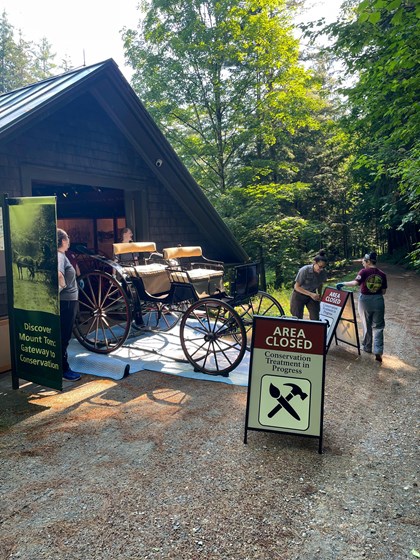
NPS Photo

Billings Family Archives

NPS Photo

NPS Photo
The Surrey carriages were the first needed to be rearranged, so a team of conservators from Harper’s Ferry Center and Curatorial staff meticulously shuffled the carriages to how they are displayed now. Rearraigning these Carriages allows for better access to clean them, better access for visitors to view them, and let the conservators do more specialized cleaning while they visited. This involved taking the Surrey out onto the carriage road, where it used to commonly travel!
The Surrey, named for the county in England where it originated, was introduced to America in 1872 where it became a rather popular carriage. The Surrey was so popular that it was even mentioned in the musical Oklahoma! Specifically, in the song “The Surrey with the Fringe on Top”, even one of our Surreys used to have a similar parasol installed! The three Surrey’s featured in the parks’ collection were regularly utilized by the Billings and Rockefeller families. Frederick Billings noted that he, “Rode with [my daughter] Lil after the 4 ponies” in 1885, while the Rockefellers used one of the Surreys for their granddaughter Rachel Weber Ortiz wedding in Woodstock in 1990.

NPS Photo

NPS Photo

NPS Photo

NPS Photo
Once the carriages were rearranged in the Woodshed, the conservators were able to thoroughly clean them. This process of deep cleaning was done by applying mineral spirits on every part of the carriage then removing the excess off with a clean rag. By repeating this process, evidence of rodent urine, dust, and other residue which had accumulated over time were removed. You can see a dramatic improvement on the yellow Breaking Cart!
Featured above is the Breaking Cart, which is a type of wagon utilized by a single driver. We have three wagons in our collection. Many wagons were used for farm management historically, but these wagons are viewable and rideable at the Billings Farm and Museum today. You can see a photo of one on the cover of “Vermont Life” in 1984 when the Billings Farm and Museum first opened! The wagons that are viewable in the parks’ collection today were used for racing and exercising horses. Both the Sulky and Skeleton Wagon were both raced at the Windsor County Fair.

NPS Photo

NPS Photo
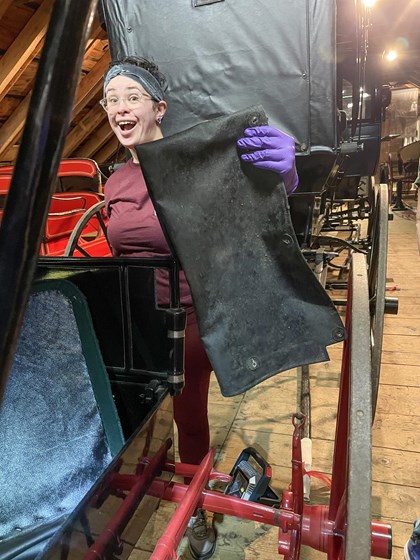
NPS Photo

NPS Photo

NPS Photo

Billings Family Archives

Billings Family Archives

Billings Family Archives
Besides cleaning, some of the carriages needed more intensive preventative conservation treatment, such as the Buggy seen below. The carriages were refurbished in the 1980s to include new upholstery. Unfortunately, as time went on and the carriages remained unused the upholstery attracted various bugs and rodents. In order to mitigate this issue and hopefully prevent further damage, staff intensively vacuumed and did fine tweezer cleaning to remove contaminants. During this process, other components of the carriages were found, such as side windows and parts to extend the parasol of the carriage, which is on display today!
Two Buggies are in our parks’ collection today. Commonly used in America, were these light weight, single driver, single horse driven wagons. Frederick Billings purchased several Buggies from Brewster & Company in New York City, which was one of the largest and most fashionable carriage manufacturers of the Victorian era. Photos above show multiple Buggies being driven by family friends and Ehrick Billings in the 1800s.
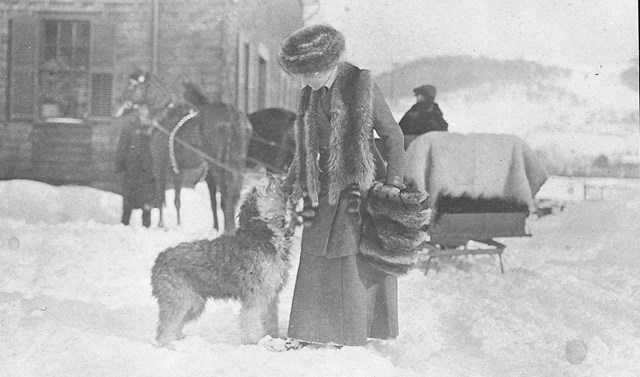
Billings Family Archives
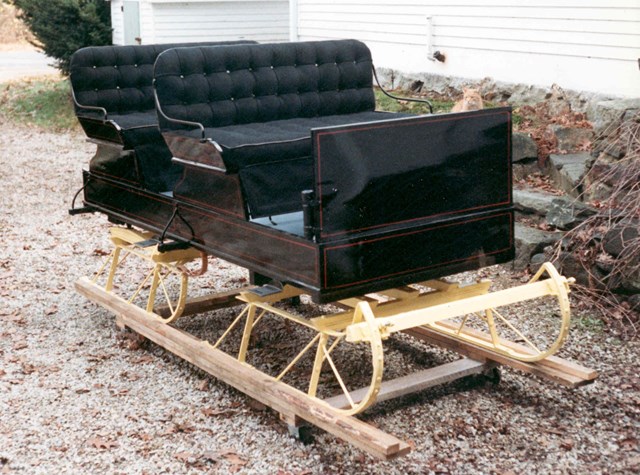
NPS Photo

NPS Photo

Billings Family Archives
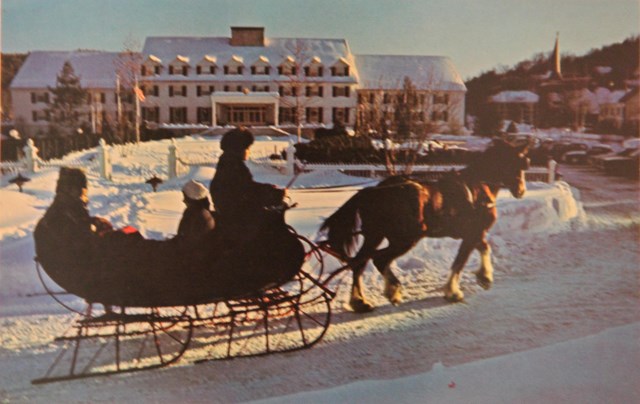
NPS Photo, MABI 4658
To prevent bugs and rodents from attacking the carriage upholstery in the future, Tyvek covers were added. Instead of having these on view in the exhibit, these covers were mainly placed on the carriages out of sight. Some cushions were simply wrapped in Tyvek such as the Sleigh seen here. Other cushions had to be freeze treated before, which is an effective treatment to ensure pests that may be hidden within the fabric or stuffing themselves were eliminated. Then, custom sewed Tyvek covers were made for long term storage.
Sleighs are the last major category in the parks’ animal drawn vehicle collection. There are three sleighs in the collection, which were purchased by the Billings family between 1893-1895. Sleighs were a necessity, for both leisure and work, when it came to Vermont winters. One of the sleighs on exhibit today was featured on postcards for the Rockefeller founded, Woodstock Inn. Another sleigh can be seen above in a photograph of Elizabeth Billings and her dog “Hero” traversing the Carriage Roads in the Winter.
1John E. Auwaerter George W. Curry, CULTURAL LANDSCAPE REPORT FOR THE MANSION GROUNDS MARSH-BILLINGS-ROCKEFELLER NATIONAL HISTORICAL PARK WOODSTOCK, VERMONT Volume 1: Site History (Cultural Landscape Publication Olmsted Center for Landscape Preservation National Park Service, Boston, Massachusetts, 2005), 110.
